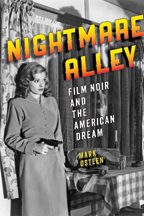By choosing the rather bleak Edmund Goulding noir classic Nightmare Alley (1947) as the namesake for his new book, author Mark Osteen surprises with his fresh approach to films noir. He concentrates on the major antagonists, so to speak, of the American dream, and the American pursuit of happiness, a constitutional right in a way. But then, it is the pursuit that is (or should be) guaranteed, not happiness as such. It is with this problem that Osteen sees many film noir characters struggle; and mostly they surrender to the conflict.
 For the issues of the initial promise to be an American, in Osteen’s interpretation the ideals of free enterprise and personal liberty as well as the possibilities of upward mobility, equality, home ownership, and undying hope are forever out of reach for those characters, and not due to individual failure and inability but because that promise was not meant to become redeemed anymore it seemed, therefore, symbolizing a spirit of loss in post WWII U.S. society.
For the issues of the initial promise to be an American, in Osteen’s interpretation the ideals of free enterprise and personal liberty as well as the possibilities of upward mobility, equality, home ownership, and undying hope are forever out of reach for those characters, and not due to individual failure and inability but because that promise was not meant to become redeemed anymore it seemed, therefore, symbolizing a spirit of loss in post WWII U.S. society.
“Made during a period marked by social and political upheaval, films noir test and critique both the principles of the American Dream,” for WWII and its aftermath brought completely new roles for returning servicemen and women. Newly established roles in the family and in the workplace made life complicated. At any rate, the war affected almost all Americans and left a massive impression in most biographies. Some experiences were good, even priceless; others were terrible and left many returning soldiers traumatized, damaged and forever mutilated.
Little wonder then, that many noir characters are somewhat weird, act strangely – to put it mildly – or are just plainly insane. This for Osteen explains the presence of equally many psychiatrists, hypnotists, psychologists and the psychiatric ward as an almost common location in many of the noir movie plots; psychic disorder and people with mental conditions populate those plots.
These and other factors, as is Osteen’s conclusion, made “… films noir ask whether the American Dream of liberty and democracy is still viable and, if so, how it may be altered or fulfilled.”
So one of the fresh approaches he offers is the investigation of the many dream sequences in films noir; a good approach never done in that detail so far. Other chapters in Nightmare Alley deal with missing persons, the Doppelganger and switched identities, various kinds of veterans with self-inflected disabilities, forgery as a theme, noir automobile culture, jazz in noir, female directors of noir and noirs directed by leftist artists (called “red noirs” by the author.)
Osteen’s chapter “Nocturnes in Black and Blue: Memory, Morality and Jazz Melody” alone is a superb text that stands out among the other approaches to this special topic. His other chapters here are worth a read too.
Review by Dr. A. Ebert (C) 2013
Mark Osteen. Nightmare Alley: Film Noir and the American Dream. Johns Hopkins University Press, 2013, 336 p.
